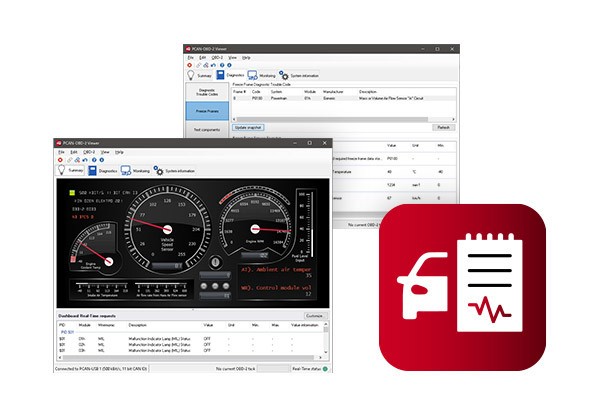PEAK Systems has updated its free OBD2 software for Windows, the PCAN-OBD-2 Viewer, now at version 1.2. This powerful tool is designed to work with their OBD-2 API (Application Programming Interface), enabling engineers and car enthusiasts to delve into the world of On-Board Diagnostics (OBD-II) on their Windows systems.
For anyone involved in automotive diagnostics or simply curious about their vehicle’s performance, understanding OBD-II is crucial. It’s a standardized system that provides access to a wealth of information about your car’s engine and other systems. OBD-II specifies everything from the diagnostic connector type and pin layout to the communication protocols, data formats, and parameters monitored within your vehicle. The communication standards are rigorously defined by SAE J1979 and ISO 15031-5, with CAN Bus implementation detailed in ISO 15765-4. Essentially, OBD-II operates on a client-server model, allowing software like PCAN-OBD-2 Viewer to request and display diagnostic data.
The PCAN-OBD-2 Viewer is designed to fully support all OBD-II services that are transmitted via the CAN Bus. Imagine a virtual cockpit right on your Windows screen: this software graphically presents real-time data through analog and digital instruments. Beyond the cockpit view, you can also select specific parameters to be displayed as graphs, offering a more detailed analysis. This includes the ability to export these graphs and the associated data sets for further review or reporting.
Furthermore, the software provides essential diagnostic capabilities such as reading Diagnostic Trouble Codes (DTCs). These codes are crucial for identifying issues within your vehicle. The PCAN-OBD-2 Viewer not only displays these DTCs but also shows available test results, giving you a comprehensive overview of your vehicle’s diagnostic status.
Key Features of PCAN-OBD-2 Viewer:
- OBD-2 Standard Compliance: Fully compliant with the OBD-2 standard (ISO 15765-4) for accurate diagnostics.
- CAN Bus Communication: Utilizes CAN Bus interface of the PCAN series for reliable physical communication.
- Comprehensive OBD-2 Service Support: Supports all OBD-2 services transmitted over CAN Bus, ensuring wide-ranging diagnostic access.
- Customizable Virtual Cockpit: Features configurable graphical representation of data using analog and digital instruments for intuitive monitoring.
- Configuration Management: Allows saving and loading of configurations for personalized and efficient use.
- DTC and Test Result Display: Clearly displays Diagnostic Trouble Codes (DTCs) and available test results for quick issue identification.
- Freeze Frame Data: Reads and displays freeze frame data, which is recorded when an error occurs, providing valuable context.
- Emission-Related Data Listing: Provides listings of emission-related data and offers optional graphical display of individual parameters for in-depth analysis.
- Data Export: Enables exporting of graphs and OBD-2 communication records for data analysis and documentation.
While PCAN-OBD-2 Viewer focuses on the software side, it’s worth noting the hardware that often complements such tools. For instance, boards like the Teensy 4.1 Triple CAN Bus Board enhance the capabilities for developers and advanced users working with CAN Bus and OBD-II systems.
In conclusion, the PCAN-OBD-2 Viewer offers a robust and free OBD2 software solution for Windows users. Whether you are a professional engineer or a car enthusiast, this software provides valuable insights into your vehicle’s diagnostics and performance. Its comprehensive features and user-friendly interface make it an excellent tool for anyone working with OBD-II and CAN Bus systems.
